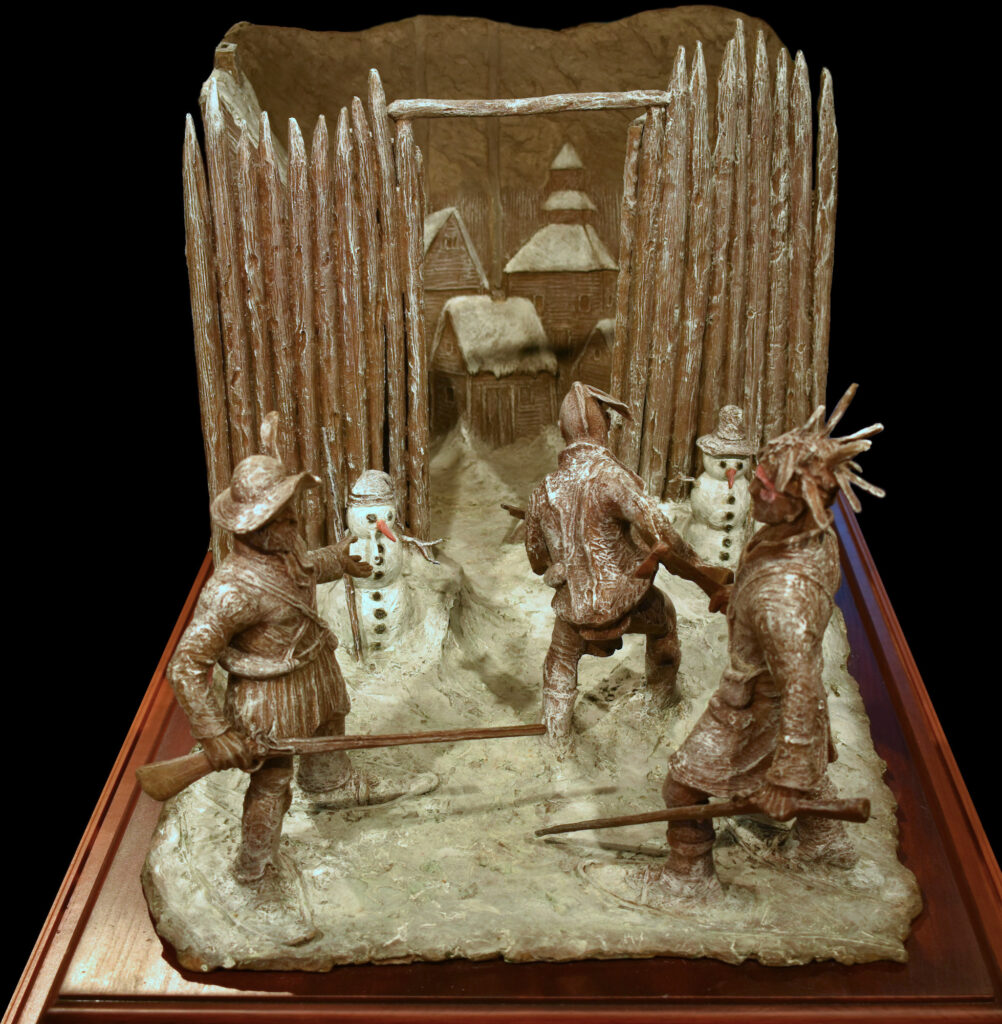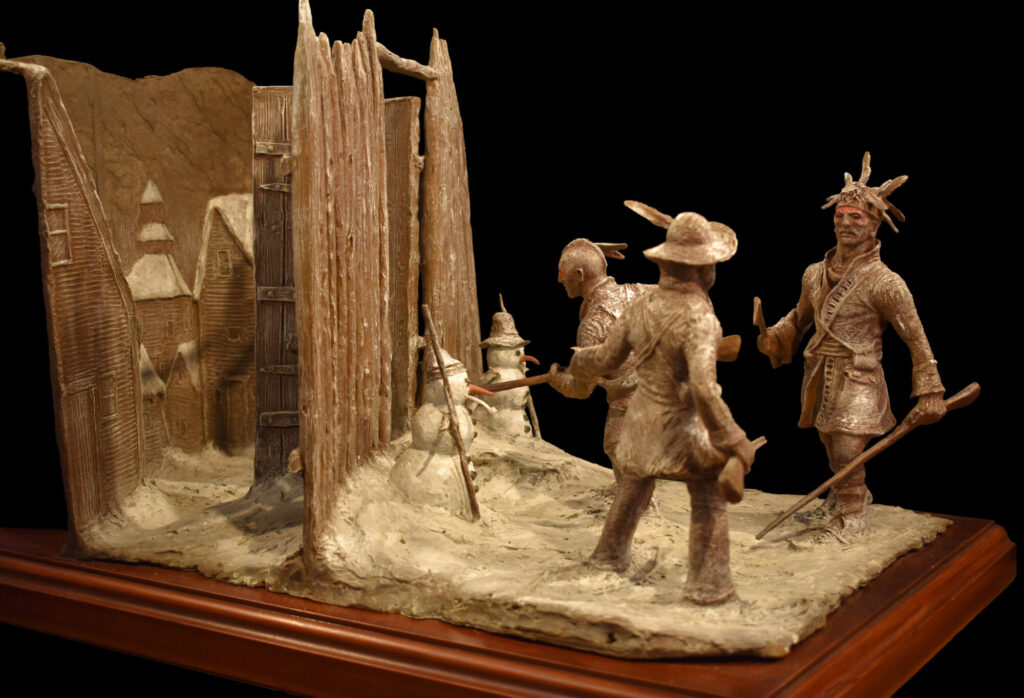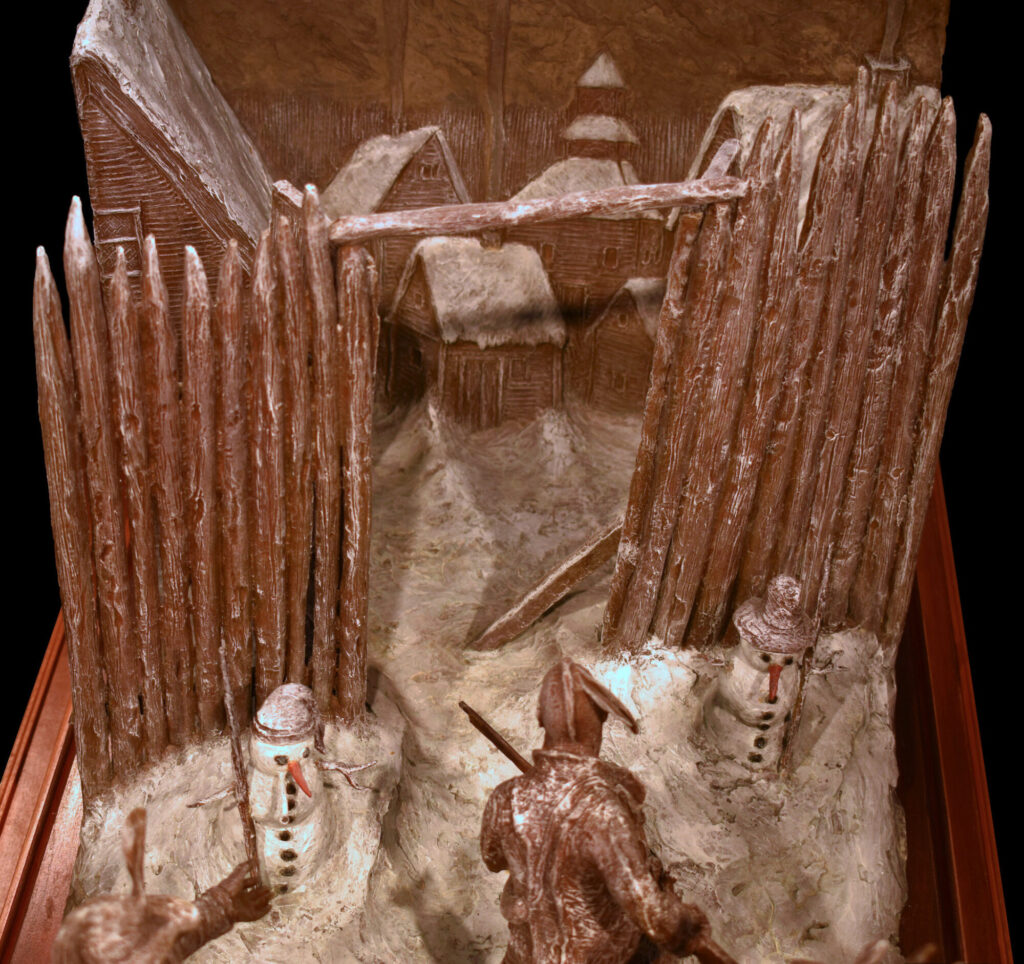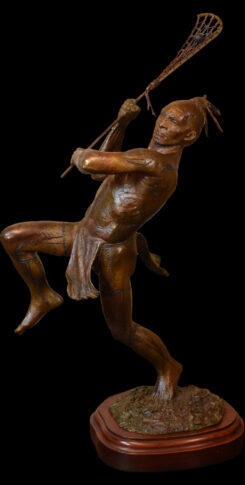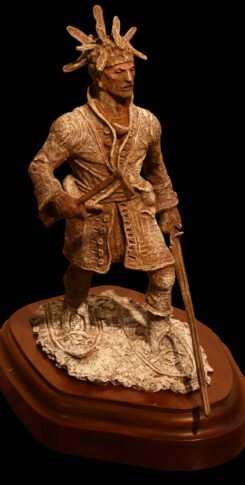“Les Gardiens de Neige”
2020 | Bronze edition: 25 | Width: 18′ | Depth: 27″ | Height: 16″
On the bitterly cold night of February 8, 1690 the 400 Dutch inhabitants of Schenectady in the province of New-York, (formerly Nieuw Nederlandts), oblivious of danger, lay asleep in their beds. The men who were entrusted with guarding the town were instead inside Douwe Auke’s Tavern. Choosing to ignore the warnings of their Mohawk neighbors and Albany Mayor Peter Schuyler of the likelihood of attack, the gates of the town were left open and unguarded. Unguarded that is but for two snowmen on either side of the gate. The townspeople probably felt as their near neighbors in New England felt: “No fear of Indian attack until oak leaves are the size of mouse’s ears.” Though a colorful metaphor, it unfortunately proved to be tragically wrong. The simple peasants of the town, farmers and woodsman, were possibly unaware that across the Atlantic war had been declared between England and France. “King William’s War” had spread to America.
A devastating attack on Lachine near Montreal by 1500 English-allied Iroquois warriors in 1689, caused to be called back from France for his second term of office Louis de Buade Comte de Frontenac. The newly arrived Governor – General of Canada resolved to take the offensive. With Canada reeling, the fiery and fearless Frontenac, despite his 70 years, was the man of the hour. Launching a three-pronged attack, not against the Iroquois who were as elusive as ghosts, but against the English: from Quebec toward Casco bay and coastal Maine, from Trois Rivere to Dover and coastal New Hampshire and from Montreal toward Albany/Schenectady. These attacks were devastating and militarily unqualified successes. Canada joyfully celebrated its reversal of fortune and Frontenac was declared the Savior of New France.
The three week journey from Montreal to Schenectady for the 210 French and Indians sent out by Frontenac, was so grueling that some afterwards declared that had they met any resistance, they all would have surrendered. But resistance there was none. Passing through the open gates and the silent, sentinel snowmen, the two French commanders, D’Allebout de Montet and LeMoyne de Sainte-Helene, along with the chief of the Mohawks of Saut St. Louis known as the “Great Mohawk” by the French and by the Dutch as Kryn, had their men silently disperse through the town. The blood-chilling cry of the war-whoop now shattered the darkness commencing the attack. It proved to be the death knell of 60 inhabitants and more than 100 who were initially made captive. Though as horrific for Schenectady as it was, it could have been even worse. One stockaded house across the river was intentionally spared. It was the home of the chief magistrate, John Alexander Glen. He and his wife had saved the lives of a number of French soldiers captured by the Mohawks and showed them great kindness. As a result, Glen was now led before the wretched captives of the town and told that besides his immediate family all his kindred should also be spared. Glen stretched this privilege to the utmost until the Indians, disgusted at his multiplied demands for clemency, declared that everyone seemed to be his relation. As well, at the time of the attack 30 local Mohawks were guests in the town. All were spared by their Christian Canadian kin and to conciliate them further their request to free 60 old men, women and children was granted. Ultimately the invaders headed north with only 27 captives and 30-40 captured horses pulling sleds loaded with plunder. Schenectady lay in ashes, all but 5 or 6 houses left standing.
Footnote: Word of the attack on Schenectady soon reached Peter Schuyler, Mayor of Albany. Rounding up a force to go in pursuit they headed north though were never able to overtake them. Schuyler and his men eventually ran out of food and finding themselves freezing and starving came across a band of allied Mohawks, also on the trail, who were gathered around a large kettle cooking over a blazing fire. They offered Schuyler and his men some of this “broth” which they had. In his 1690 journal Schuyler then wrote: “They offered us a second helping but as I glanced over appeared in the ladle the hand of a Frenchman which quickly put an end to my appetite.”
“I related this tale years ago to a good friend and great chef who for years owned The Old Newfane Inn in Vermont. Upon hearing the story Eric replied: ‘Ah, this must be the original French onion soup!'”
Jud Hartmann, 2021
See also Kryn, A Study for Nightwatch.

